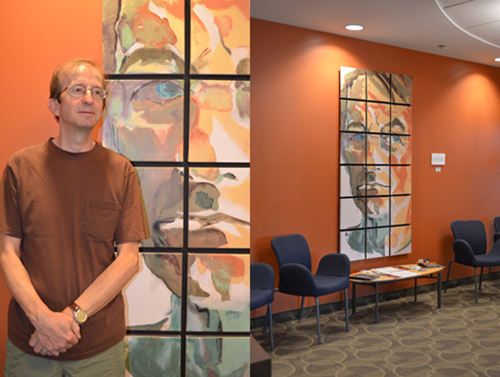 David Kearn and his self portrait: “Eighteen Pieces of Me”, Acrylic on Canvas This summer I promised myself, I’d make time to check out more art shows in the city; it’s something I love but rarely have a chance to do while running my business. Recently I visited “Portraiture by the Foot” an exhibition by my friend painter, David Kearn. I was fortunate to be given a personal tour of the show by David and his wife France… two very animated souls who are passionate about art. Thoughtfully arranged by Eliane Saheur, the exhibition is integrated into the first floor AOE offices of the Shenkman Arts Centre. Visitors are able to view 33 portraits along its corridors and walls as well as in the offices of its employees. Unlike many exhibitions that are contained in the standard contemporary “white cube” setting, I love this show because it has a real lived in feel; one that can be enjoyed by visitors and occupants alike.
 David Kearn's portraits are seamlessly integrated into the office space of the AOE: (left) “Lanie” (his sister-in-law), Oil of Canvas; (right) “Mindy”, Oil and Acrylic on Canvas The first part of my tour featured the talents of David’s students. I was impressed by three large grid panel portraits they had made of famous Canadians. As part of the process, each student was given a square fragment of a photo portrait to reproduce and complete in the medium of their choice. In final form, these slightly askew, collage-like renderings are fascinating animated portraits of three of Canada’s cultural heroes as well as a fine testament to David’s role as teacher. As I expressed my pleasure with them, David was excitedly off on a tangent pondering which great Canadian he’d select next … “Perhaps opera star Measha Brueggergosman!”, he exclaims in his charming British accent.
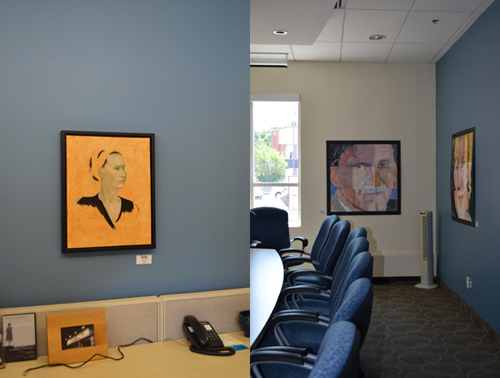 The work of David's students on the right: "A Sum of Parts” (Lieutenant-General Roméo Dallaire; side view of writer Margaret Atwood), Various Media No exhibition of portraits is complete without at least one portrait of the artist himself. David’s includes four. An iconic, fluid watercolour one which he has photographed and then transformed into a much larger piece composed of small panels arranged in a grid – his largest portrait to date. Inspired by his work with his students, this latter self portrait “Eighteen Pieces of Me” is a serene representation of the soft-spoken artist. Ever ready to push the boundaries of his portrait making, the show also includes an expressive pastel portrait of him as well as another abstract version “Mosaic One” composed of loosely painted squares. From a distance they come together to form his face in a manner that mimics the pixels in a digital photograph. Throughout the show, there are several examples of David working with the same subject in various styles and mediums – one even includes glitter, “but very tastefully done”, his wife France adds.
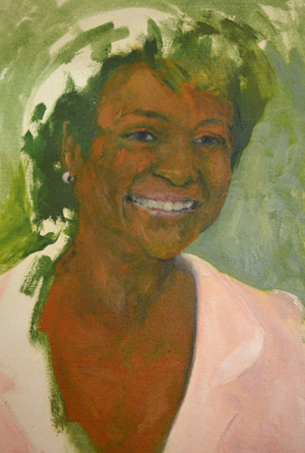 David Kearn, “Emergence Three” (Michaële Jean former Governor General of Canada), Oil on Canvas Equally alluring are his portraits of others. One such is former Canadian Governor General, Michaële Jean. David captures her likeness in spontaneous flowing brushstrokes, unusual layered pops of colour as well as his trademark style of leaving portions of the portrait unfinished. I like this latter tactic – it reminds me as a viewer, like the sitter whether in painting or real life, we are all works in progress. I’m drawn to the unexpected fleshy forest green colours beneath Jean’s skin – they beautifully complement her dark-skinned features and pink tones of the piece. I note, however, that she has no hair! I tease David about this and he jokes: “She was always changing her hairstyle then so I left it out!” And yet, he still manages to capture her effervescent personality and infectious smile. In other portraits, David’s ability to reveal the psychological interior of his sitters is made evident through his use of colour, texture, background/landscape and title. In “Boundless” a nude model sits, somewhere between heaven and earth, on a mirror-like tiled floor which reflects the sky; in “Disquiet” a young woman slumps against the backdrop of a ghostly brick wall; and, akin to Pre-Raphaelite painter John Everett Millais’ “Ophelia” in “Slipstream” a woman’s seemingly lifeless body floats, face up, along the banks of a river… haunting portraits that lend insight into the stories behind the mindscapes of the sitters as David imagines them.
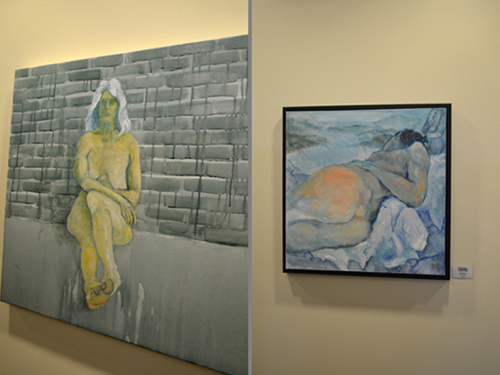 David Kearn, (Left) “Disquiet”, Acrylic on Canvas; “In a Landscape”, Oil on Canvas Among my favourite portraits are those of David’s wife and niece. It’s interesting to note that many of the pieces have the sitters’ reaction to their portrait posted on the wall beside them – in each case all are pleased with the results. A portrait of wife France situates her between the twin cities of Ottawa and Hull. She divulges this is because she’s a blend of French and English Canadian, and further adds that David has accurately captured her abnormally large hands!… a detail that escaped me because I’m particularly struck by way he’s harnessed the real life intensity of her gaze… never leaving the viewer; scrutinizing them… ready to make some profound observation about the world around her. I tell David France’s stare and the hazy landscape behind her make me think of Leonardo da Vinci’s “Mona Lisa” (“La Gioconda”). This delights him. It would seem he consciously incorporates the strategies of old masters into his some of pieces. Even the arresting portrait of his young niece, Carolyn, who glances knowingly at the viewer, echoes another famous portrait “Girl with a Pearl Earring” by Dutch painter Jan Vermeer. Rather than pearls, however, in David’s contemporary version “Carolyn by Moonlight” she sports large hoop earrings. I can’t imagine anything more perfect than to be immortalized in such a classical manner. It’s no surprise Carolyn and France take great pride in David’s skills as an artist.
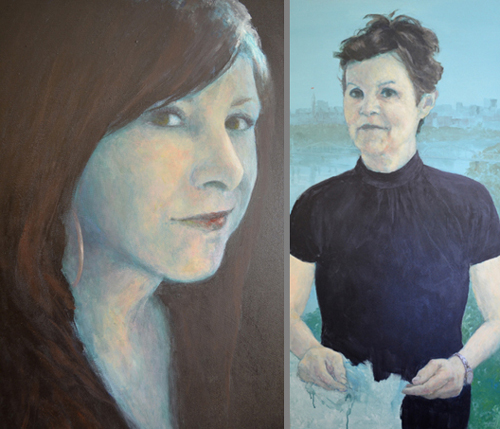 David Kearn: (Left) “Carolyn by Moonlight" (detail of niece), Oil and Acrylic on Canvas; “On Both Sides" (detail of wife France), Acrylic on Canvas As with all stimulating exhibitions, “Expressive Portraits: Portraiture by the Foot” leaves me excited about the potential of portraiture and how I could use some of the ideas I’ve discovered in the show to build on my own portrait making skills. I was also inspired to try my hand at painted or charcoal portraiture… David, you may see me in yet another one of your classes! I’d really love to take part in the creation of a famous Canadian grid panel session!
If you’re in town, be sure to check out David Kearn’s show at the Shenkman Art Centre in the AOE Gallery which is on until August 23, 2012. Summer hours are Monday to Friday, 8 am to 4 pm at Shenkman Arts Centre at 245 Centrum Boulevard. Be sure to see his website and Break a Brush blog for more photos from the show. Thanks for a memorable tour David and France! Thanks too, to the AOE staff for warmly welcoming me to photograph their facilities and answering my queries.
If you have any thoughts about David’s work, I’d love to hear from you.
Other Related Links:
Defying My Comfort Zone: A Plein Air Class with David Kearn
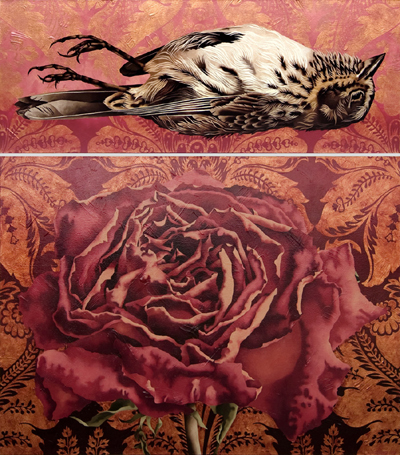 Helen Gregory, “Desiccate III”, Acrylic on canvas, 54" x 48", 2007. Image used with permission from the artist. Have you ever felt an instant connection to an artist’s work? In the work of Newfoundland painter Helen Gregory, I’ve found a kindred spirit…
A Withered Rose and Dead Sparrow Caught My Eye…
I first spied Gregory’s work a few years ago while scouring art magazines for collage fragments. Her painting: “Desiccate III” of a withered rose and dead sparrow caught my eye. I didn’t fully understand the context of her work then, but it touched a dark, sentimental place in my soul. To my surprise last month, while wandering through the Museum of Nature here in Ottawa, I discovered her exhibition “Unrequited Death”. While the somewhat morbid nature-inspired themes of her paintings aren’t for everyone, I was instantly drawn to them. Noting a familiar group of South American bird specimens I’d used in a couple of my collages in one of her paintings, I was thrilled to see Gregory shared a similar fascination for taxidermy as well as the printed patterns of textile designer William Morris. I loved the way she incorporated the latter into the backdrops of a number of her pieces. As an artist who myself has held a life-long obsession with death and memory, I found Gregory’s offerings rendered in the finest detail, most exquisite colours and intricate patterning hard to resist! Lingering between the moment of death and disintegration, I sensed the artist’s need to draw one last breath from what remains of life before it passes into eternity. In a spiritual vein, I felt, through the act of painting, she transfigures the animal corpses and objects she depicts. Enlarging them to a majestic scale and rendering their minutest detail, she imbues them with highly-charged emotional depth and personal meaning.
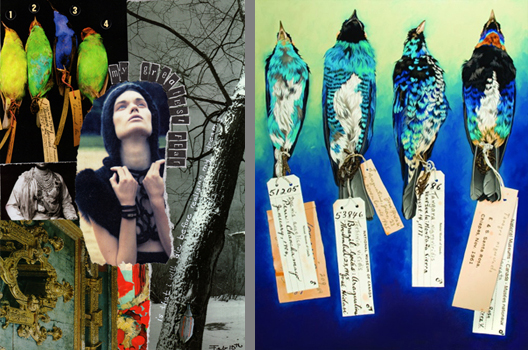 Image Left: Michelle Casey, "My Greatest Fear", Collage / Mixed Media Journal Page, 6.5" x 8", February 12 2010; text: "My greatest fear is to die without realizing my dreams." Image Right: Helen Gregory, “Blue Tanagers”, Acrylic on canvas, 72" x 54", 2009. Image used with permission from the artist. A Darkness Beneath Her Sweet Exterior…
As well as visiting the exhibition, I also attended a talk given by Gregory. Dressed in a deep peach dress as bright as the plumage of the exotic birds she depicts, Helen Gregory’s cheerful presence lit up the room like a ray of sunshine… when she spoke however, a disquieting silence filled the air as she revealed the contents she kept in a chest of drawers beneath her bed… natural specimens and dead things sometimes in the process of decaying; unnatural things for a six-year old to collect. As I listened to her, the hair on my arms stood on end – I sensed the underpinnings of a great character for a Stephen King novel or Tim Burton film – a small curious soul more than a little intrigued by “nature morte”! Like her work, Gregory’s description of herself as a collector and painter of natural, sometimes morbid curiosities such as dead birds, hybrid human/animal skeletons, hornet’s nests and giant squids (like the ones found on ancient maps) hints at a darkness beneath her sweet exterior. Intrigued, I was eager to learn more about the artist and her work.
Building Her Very Own Cabinet of Curiosities…
The daughter of a professor of chemistry, Gregory reveals she might have turned out to be a biologist or a doctor. Instead, like a post Victorian-day naturalist and scientist (and interior designer I might add*), Gregory’s passion for building her very own cabinet of curiosities of specimens continued into adulthood and art studio. Initially, she photographed and painted images of the dead birds she found in her driveway or along walks. On one such scary venture, while photographing a young dead crow, she found herself encircled by a menacing flock of them who screeched at her! This incident affected her intensely and inspired her piece: “Crow Funeral”. Gregory has many intriguing tales that surround the creation of her paintings. Nowadays though, she doesn’t have to fear for her safety as news of her fame as a painter of dead things spread, she gained access to centuries-old museum specimens and her work blossomed further.
Visual Artist and Curator…
Her passion for natural specimens has led to her current stint as resident artist at Museum of Nature as part of her PHD studies. As well as examining the museum’s inventory, she’s also curating a display for their bird collection; a task she revels in. Interested in shaking up the usual display of bird “skins”**, Gregory reveals she’s going to juxtapose them with a lively group of century-old (Bourguignon) song birds mounted on fancy glittering (almost tacky) painted bases along with a set of porcelain Lenox Garden Birds. Her keen insight and sense of humour demonstrates the multiple roles birds play in our lives whether it’s for educational or sentimental reasons. I’m sure they’ll have museum goers doing double-takes! Through her paintings as well, Gregory carefully and strategically uses similar tactics to turn viewers’ heads. In the near future, I’ll share a few of my favourites with you.
If you’re interested in seeing Helen Gregory’s exhibition, be sure to drop by “Unrequited Death” at the Museum of Nature or visit her website at the link below. I’d be curious to know if her painting of death disturbs, delights or moves you!
* Note: I say this because of her love of display and wall paper.
** Note: Where birds are displayed laid out flat and labeled.
Just to let you know I’ll be taking a couple of weeks off from blogging. Will be back August 5, 2012. Have a great couple of weeks! 🙂
Other Links:
Helen Gregory’s Website
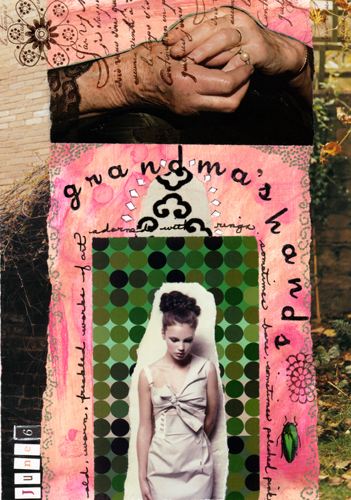 Michelle Casey, "My Grandmother's Hands", Collage / Mixed Media Journal Page, 8.5 x 6 inches, June 6 2010. Text: "old, worn, freckled works of art adorned with rings, sometimes bare, sometimes polished pink." Many summers ago while she was visiting from England, my grandmother Sophie and I would spend time painting our nails together. We hadn’t seen each other for years so it was a great bonding activity. While doing this, she told me stories about her life as well as advised me on the best nail colours to choose. A wise old nail sage, she informed me which shades would make me look like an elegant young lady and which ones would make me look like a “tart”! Now that she’s gone, I miss those times. Well, it’s been a crazy busy six months, so what do you think I did the first free moment I had? I declared a spa day and did my nails, of course!
Recently I ran across two wonderful collage-like ideas for layering words and textures onto your finger nails. One I discovered from a young student I was teaching… I glanced down at her nails and noticed she had these tiny words running across them! Smitten, I asked her how she achieved this fabulous look which she excitedly relayed to me. The second, I came across while browsing through Sephora. I noticed that a sales girl had the loveliest metallic blue nails with glitter polish painted only on her nail tips. I liked that the glitter didn’t cover the whole nail – I find that a bit overkill. Applied only to certain sections of her nail on the upper or lower edges, the glitter looked cool. I learned her secret and was off to try these two techniques on myself which I’m also happy to share with you!
 Left to Right: supplies; dipping nail in rubbing alcohol; pressing newsprint onto nail; adding top coat to finished nail. Word Nails
Supplies: pastel-coloured nail polish*, top coat polish, small bits of nail-size newspaper, rubbing alcohol, cotton pad cut in quarters, nail polish remover.
1 Paint your nails with at least two coats of pastel nail polish.
2 Let your nails dry for half an hour.
3 Cut a cotton pad in quarters.
4 Cut out small sections of newspaper* (a little larger than your nail size); make sure the newsprint ink smears when you rub it or it won’t work.
5 Dip a nail in rubbing alcohol.
6 Place a newspaper bit on top of your nail; pat down on it with cotton pad for a few seconds and remove.
7 When finished adding words, let your nails dry for about ten minutes before applying top coat polish to protect the newsprint from rubbing off.
8 Remove any words on your skin with nail polish remover.
*Notes: Pastel or matte colours make the words “pop” better than other polish colours. I used Essie colours: Van D’Go (pink), Turquoise & Caicos and Nice is Nice (lilac). Using newspaper print in other languages like Arabic or Chinese would be interesting, too. You’ll probably have to practice this a few times to perfect the technique.
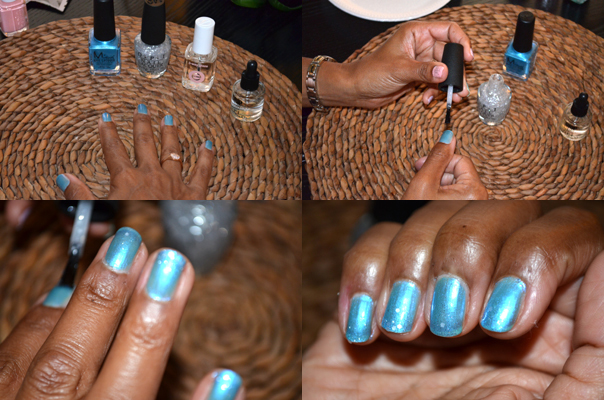 Left to Right: supplies; adding coat of metallic blue polish; adding coat of glitter polish; finished nails. Sparkling Nails
Supplies: blue metallic nail polish*, glitter nail polish*, top coat polish.
1 Apply two to three coats of blue metallic nail polish.
2 Apply one to three brushes of glitter polish near the lower half of your nail tips*.
3 When glitter is dry, apply top coat polish to seal.
*Notes: I used Misa: Lounging by the Pool (metallic blue) & OPI Pirouette My Whistle (glitter). I think luminescent metallic polish colours look best with this technique. This OPI brand of polish is great because it contains different sizes of glitter and goes on smoothly… often a single coat of glitter is enough.
So why not take a summer spa break with your mom, girl friend, grandma or the kids to spice up your nails … and expand your collage skills at the same time! 😉 If you have any collage-inspired nail decorating ideas, I’d love to hear them.
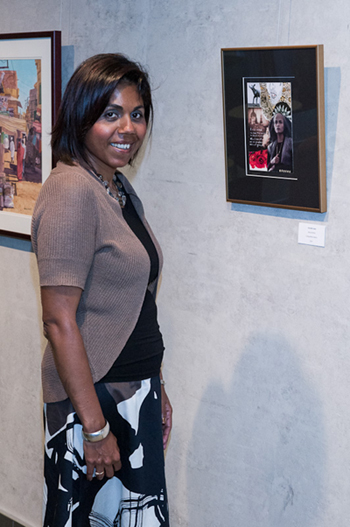 Michelle Casey, Canadian Gharana Arts Opening, Ottawa, June 2012 In June I was pleased to participate in a group art exhibition: “Inspirations of India” held by the Canadian Gharana Arts Festival here in Ottawa. The event was a celebration of arts being practiced by Indo-Canadian and Canadian artists alike inspired by India. For three days: music, vocals, dance, literature, visual art and film were featured at venues across the city. It was the festival’s first time in Ottawa. The opening was a lively event replete with mouth-watering India cuisine!
Many thanks to those friends and relatives of mine who made it out to the opening or stopped by to check out the show during the weekend. Special thanks to Rashmi Gupta, Arts and Literature Coordinator, for overseeing the exhibition and Shenkman Centre Arts Programmer Mike Taylor for taking such great care coordinating the exhibit – the Shenkman Arts Centre is an amazing space and the show was set up beautifully in the Lalande and Doyle Exhibition Space. Last but not least thanks to my husband Kevin Casey for his support and my photographer Peter Farris Manning for capturing these lovely photos of the show.
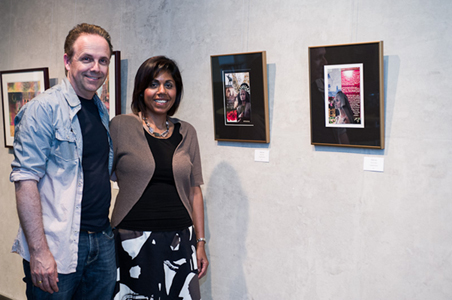 Kevin & Michelle Casey, Canadian Gharana Arts Opening, Ottawa, June 2012
 Michelle Casey & artist Krystyna Sadej, Canadian Gharana Arts Opening, Ottawa, June 2012
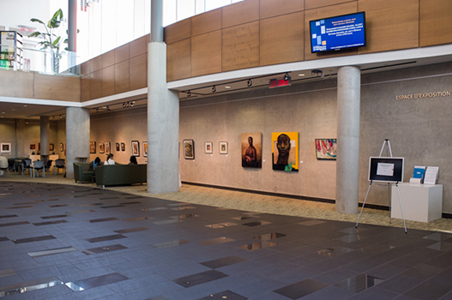 Lalande & Doyle Exhibition Space, Canadian Gharana Arts Opening, Ottawa, June 2012
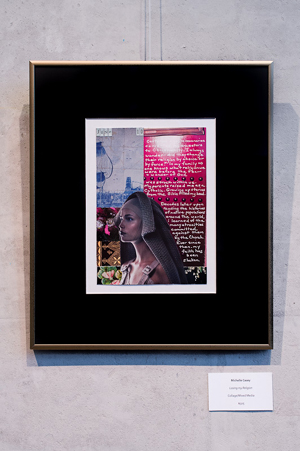 I selected one of my favourite collages: "Losing My Religion" for the exhibition.
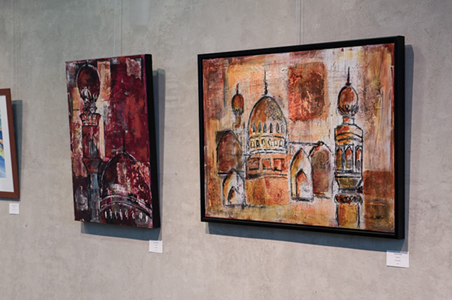 View of some art works, Canadian Gharana Arts Opening, Ottawa, June 2012
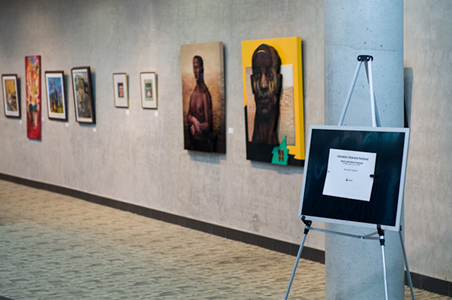 View of some art works, Canadian Gharana Arts Opening, Ottawa, June 2012
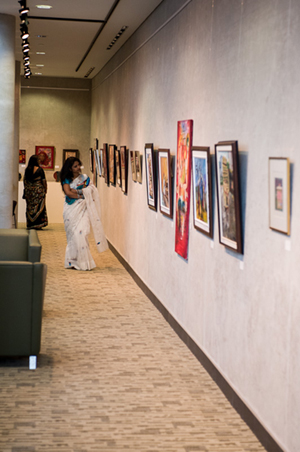 Visitors, Canadian Gharana Arts Opening, Ottawa, June 2012
 Visitors, Canadian Gharana Arts Opening, Ottawa, June 2012
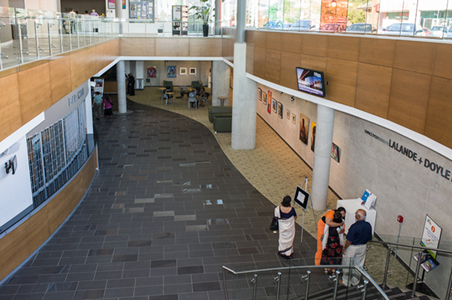 Visitors, Canadian Gharana Arts Opening, Ottawa, June 2012 Special Note: Happy Canada Day to all my Canadian subscribers! Best wishes to those in the United States who’ll be celebrating Independence Day on July 4th!
Other Related Links:
Collage Bits & Bytes: June 2012 (see Summer Exhibitions)
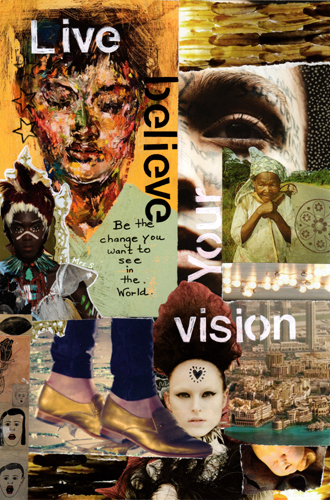 Michelle Casey, "Making a Difference", Mixed Media / Collage, 7.25 x 11 inches, June 2012. Quote inspired by Mohandas K. Gandhi. Recently, I assisted elementary school teacher Catherine and her grade six students with a collage project. After working throughout the year on a social issues theme with her class, she asked them to create a collage of the “footprint” they’d like to leave in the world: things they wanted changed for the better.
Now, I’ve never worked with young students before – let alone 24 of them, so initially I was afraid of taking on this project. However, after sitting with the class and giving them a collage art talk, I began to feel very comfortable with this enthusiastic group of students.
Weeks before I stepped in, Catherine gave the class guidelines for selecting imagery (predominantly from old National Geographic* magazines) for their collages. My role was to assist students in their collage making as well as relay some basic techniques: gluing, cutting, composing and a bit of mixed media.
Transforming the World through Collage
As I surveyed the students’ work in progress, I was impressed by their interest in world concerns. Poverty, hunger, war, human and animal rights and the future of under-privileged folks in economically and politically oppressed regions of the world stood at the forefront of their collages. A number chose emotionally-charged images to describe these heart-breaking scenes. A part of me was glad to see these kids taking these topics head on and whole-heartedly demanding a change. While another part of me wondered what these images were doing to maybe diminish their sense of optimism about the world. Nevertheless, I hoped this project would spur them on to build attitudes and careers that would help them transcend these issues even if only in some small way.
I’d love to tell you about every students’ pieces, but I must limit myself to a few here so I thought I’d share some samples of works that made me think about what it means to tackle a complex subject such as theirs – one even I found challenging!
After viewing a number of gut-wrenching collages related to poverty and disease, I was pleasantly surprised to find one student’s optimistic take on these issues. Her work focused on positive images such as a poor mother lovingly embracing her child and a doctor tenderly treating a patient. She mentioned she added two kangaroos to literally put a happy spring feeling into her collage. Even her slogan: “New days… every day new things happen” features text whose words are entwined by signs of growth and renewal: leaves and trees – her message was so uplifting!
I was also glad to see other students striking off the usual path to search for other kinds of imagery to speak of change. One young man chose basketball as a jumping off point (!) for his collage. Naturally, his board was dominated by a large basketball. He wanted to add some inspirational text so I suggested he try catch-phrases from ads, TV or sports interviews to describe the spirit of top athletes from the field. He came up with one in a few seconds! I was fascinated by the fact that he was thinking of using the best quality of his sports heroes to describe the attitude it takes to transform the world. Seeing students march to the beat of a different drum always makes me happy. After all, it’s going to take all the inventiveness we have as individuals to change the world! We don’t often think of famous political leaders pursing different avenues for change but some have. Mohandas K. Gandhi for instance tried his hand at fashion design to create clothing that would unite the divided peoples/classes of India. Even celebrities have the power to incite change. Late American Pop singer/artist Michael Jackson’s song “Heal the World” (1991) and its related foundation donated 300 million dollars to charities; as well, his songs and music videos have raised much awareness about helping others in need around the world.
In this same spirit, I was pleased to observe one young lady tackling the subject of beauty using the pages of a fashion magazine. Since this is also an important concern in my art as a woman artist, I was elated to see a “mini me”! In a thoughtful gesture this student placed images of Black and White female models side by side, courageously and confidently setting out to balance images of race in advertisements that stereotype ideals of female beauty through her own personal ad! It’s these small revolutionary acts in a student’s life that can pave the way for being a more active and conscientious future citizen.
Video of Students’ Collages
For your viewing pleasure here are some images of the students’ works in progress. I took as many good photos of the works as I could while simultaneously hopping about helping the class! My deepest apologies for the collages I missed capturing. Thanks to all the students for allowing me to share their art works.
Video of Students Collage Journal Pages (for PC click here)
Video of Students Collage Journal Pages (for MAC click here)
*Please note the video takes less than a minute to load… I appreciate your patience
Video Music: “Heal the World” (1991) by Michael Jackson
My Thoughts for the Students
Whatever you become, where ever you go in life, don’t forget these important ideals your teacher has passed on to you. Even if you don’t become a high-flying political leader, in whatever role you choose: an ordinary citizen; a working mom; a sales clerk or construction worker, do some little thing that makes the world a better place. If you reach celebrity status, remember where you came from and try to give back to the world. And, don’t forget, when you need to visualize something to transform your life or the world, collaging is a great place to start! It can help you to imagine the bigger picture and begin to see what you can do to make the changes you’d like to see.
I loved all of your collages, even the messy sticky ones and the ones with images that weren’t cut out properly – it’s all okay, with time and practice, you’ll get better at these things. The hardest part you’ve already achieved – taken a dream and tried to make it real by speaking about it with images. This takes much courage so be proud of yourselves!
Special Thanks
My deepest thanks to teachers Catherine and Christine for overseeing the students. Their enthusiastic support and guidance has taught me much in a brief time! Thanks too to my hubby/tech Kevin Casey (my “guy Friday”) for hauling supplies and assisting me with demos and presentations. Last but not least, thanks to the students who gave me such a valuable and fun learning experience – they’re my most important teachers. I will not forget their wonderful visions for improving the world!
*It’s important to note that images from magazines such as National Geographic which feature marginalized world cultures are taken from the view point of western photographers and media who have their own agendas of how these people should be portrayed for western audiences. Academics have written much on this subject. Every magazine has its biases; it’s crucial to understand something of the context their images where created in so they can be used effectively. If you’re curious to learn more, see “Film Cameras…” link below.
Other Related Links:
The Collage Artist Goes Back to School
Emma Tarlo: Clothing Matters (Gandhi)
Film, Cameras and the Documentary Encounter
Michael Jackson
It’s been crazy busy here at Collage Your World! I can’t believe it’s already June! Here are some collage tidbits I’ve been saving for you!
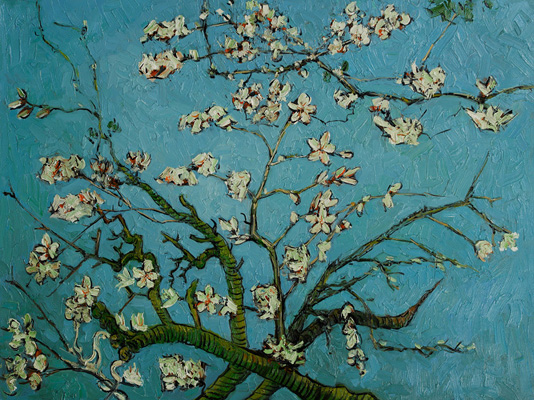 Vincent Van Gogh: “Blossoming Almond Tree, Saint Remy”, Oil on canvas, circa 1890. Ottawa Summer Exhibitions: David, Van Gogh & Me!
This summer our city is graced with the presence of exhibitions from two great painters and one collage artist: Vincent Van Gogh (who needs no further introduction), David Kearn (who familiarized me with plein air painting last summer) and me! This summer, the eagerly awaited Van Gogh: Close Up Exhibition will be featured at the National Gallery of Canada. A fine portraitist as well as landscape painter, David will be featuring his portrait work and those of his students at the Shenkman Art Centre until August 26, 2012. Be sure to check out his Break A Brush Blog for more on the show. I’ll be exhibiting two pieces: “Losing My Religion” and “Black & White” in a group show at the Canadian Indian Gharana Festival (June 22-24) at the Shenkman Centre as well. See my Exhibitions page for more details. I’ll be sure to have reviews of these shows later on this summer.
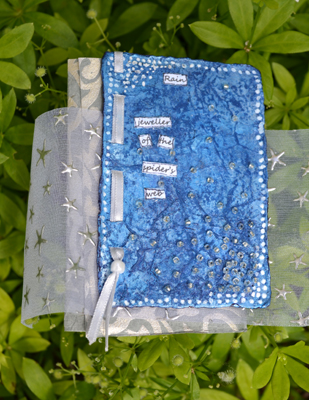 Gillian Jansen, Mixed Media, Artist Trading Card, 3.5 x 2.5 inches, 2012. Text: “Rain, Jeweller of the spider’s web”. The image was inspired by a line from the poem “Prayer” by Dana Gioia. Gillian’s ATC: A Beaded Beauty!
This April I exchanged Artist Trading Cards (ATCs) with a group of virtual friends from abroad: Gillian Jansen, Irene Rafael and Diane Salter. It’s our second exchange and I swear the cards keep on getting more marvelous each trade! Our triple theme (because yours truly was doing the selecting) was fantasy/transformation/unfurl – stuff that emerges when art is at its best. Gillian’s creative eye, inspired by the play of light on nature, spied early morning dew drops on a spider’s web and transformed them into this jewel-like treasure (see above). I love the painted texture of her card and beautiful beads she’s sewn into it. Gillian’s abstracted view of nature also reminds me of star-like diamonds in the night sky. I’m so lucky to have it in my ATC collection! Drawing on personal experiences of transformation and aspects of beauty in art respectively, Irene’s and Diane’s ATCs were equally remarkable. Diane mentioned we were lucky to have each other as mirrors to inspire each other and she’s so right! For further inspiration, be sure to check out Irene’s and Diane’s blogs.
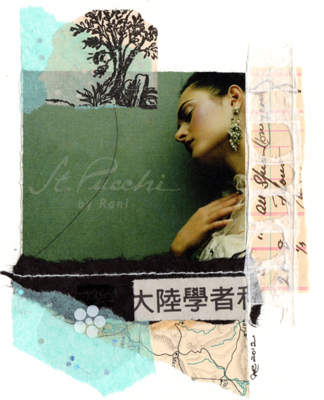 #10 of my eleven collage pages for the sewing/text/maps June 2012 book project. My No Sew June Book Project
This is the second year I’m participating in a book page project hosted by a local group of artist friends. We make pages for an art book based on the number of people participating in the project; this year eleven people are participating so everyone had to make eleven pages each! Our theme: sewing/text/maps was also chosen by your favourite scatter-brained collagist (me!) – I had such a hard time choosing! I was relieved that everyone, including those of us who can’t sew for beans (!), decided to go with my theme. For my pages, I chose several elements: Chinese newsprint, handmade papers, patterned tissues papers, map fragments and a favourite magazine image; I went to town playing with various compositional arrangements of these pieces. Here’s a sample of one of my favourite pages. I feel they ended up looking like small visual poems. Oh, did I mention I cheated a little bit by using a piece of handmade paper I found that was already machine stitched – proving if you look hard enough you’ll always find a way to work around the skills you don’t have!
 Student collage in progress... Back to School: Collaging a New World
This month I assisted a grade six elementary school class with a “footprint” themed project. Through collage, the students captured aspects of the world they wanted to change. Their dramatic pieces included key topics such as: poverty, racism and discrimination. At their age I remember shunning the daily news. I was surprised and impressed by how politically informed these students were as well as how engaged they were about transforming the social/political scene. I hope these ideals stay with them for a long time. When I see a project like this it gives me so much hope for the future. Thanks to their teacher Catherine for having the foresight to see how collage can be used to give voice to these important global concerns.
Imagine: My Summer Reading
Some of you may have already read my enthusiastic recommendation of Jonah Lehrer’s: Imagine: How Creativity Works on Facebook. Art making thrives on the concept of invention so I’m always intrigued to know more about the subject. I bought the book and am hooked! Lehrer gives plenty of insight into the social history of how various folks (CEOs, scientists, salesmen, artists, musicians, writers, surfers, bartenders, etc… the list is incredible!) came up with their most lucrative ideas. Why is this such a big deal?! Well, in getting to know their creative mind sets and environments, you too will be able to harness some of their powers to create a space in which your imagination can thrive. This is easily one of the most inspiring books I’ve ever read; it’s a great companion to another book on creativity I recommended last year by Shelley Carson: Your Creative Brain. Best of all its easy summer reading that will open up a whole new world of possibilities for you. I highly recommend it. Also see Lehrer’s brilliant Youtube video about his book.
Well, it’s back to the studio for me! I hope some of these collage tidbits motivate you to take some creative action!
I’d like to invite you to shake up your collaging by thinking outside the box. Collaging doesn’t necessarily have to involve papers, scissors and glue. You can expand your collage repertoire by layering all kinds of materials. Today I propose we collage with books! Fiction or non-fiction. It doesn’t matter; the only tools you’ll need are your hands and your imagination. Beware: this recycle-friendly art form will have you reconsidering that used book pile you were thinking of giving away!
I got this “spine-tingling” idea from my friend Peter Farris-Manning who informed me of an interesting project his daughter was assigned in English class. She was asked to make and display poetry using books – book spines to be exact! This reminded me of the found poetry texts I collaged into my journals. Except this was better, instead of having them hidden away in a journal, my poetic musings would be displayed for all to see on my shelves or coffee table – my guests would be amazed!
This week, after I downloaded a helpful video by Kaite Mediatore Stover of the Kansas City Public Library on how to create book spine poetry, I was raring to go! Kevin and I are great book collectors, so I confined myself to using one book shelf to create my poems. In less than half an hour, I devised three poems and was quite pleased with myself. The next morning I got up, wandered into my living room, looked at the books on my coffee table, added a few more and came up with another! As I paused to wonder, half way through my day, what other marvellous masterpieces I could stack up, I realized I was becoming an addict! Don’t be surprised if you do too!
How to Create Your Own Book Spine Poetry:
1. Gather three to five books. (Anymore and your pile might topple over!);
2. Lay your books sideways so you can read the spines/titles*;
3. Stack from top to bottom; use titles that create interesting imagery/thoughts;
4. If you’d like to title your poem, add another book to the top of your book pile; and
5. Volià!!! – Your very own poem!
* Note: When reading you can ignore the author’s name.
You don’t have to be a great poet to create interesting and funny poetry pieces. But I’ll bet if you are a poet, your book spine poetry will sing! I could see people getting really obsessed with this and buying all kinds of used books for this project. In fact, I can envision a whole show curated around this art form.
So now you know the secret to creating book spine poetry, I dare you to give it a try! And, please do inform me of your exploits! Here are a few of mine for inspiration…
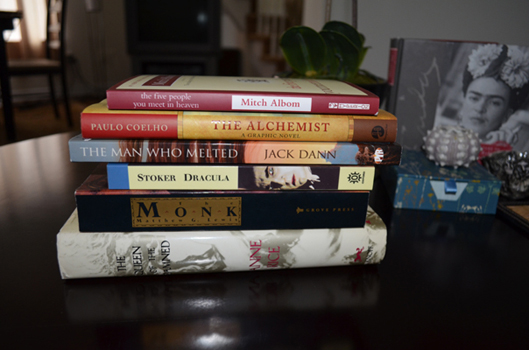 Example One Book Spine Poetry (June 2012) The Five People You Meet in Heaven
The Alchemist
The Man Who Melted
Dracula
The Monk
The Queen of the Damned
 Example Two Book Spine Poetry (June 2012) The Book of Secrets
Ask and it is Given
Bloodletting & Miraculous Cures
The Art of Happiness in a Troubled World
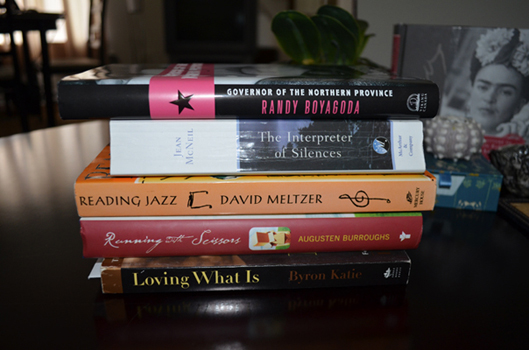 Example Three Book Spine Poetry (June 2012) Governor of the Northern Province
The Interpreter of Silences
Reading Jazz
Running with Scissors
Loving What Is
Other Related Links:
100 Scope Notes: Book Spine Gallery
Ku Leuven’s Faculty Stars Book Spine Poetry Game
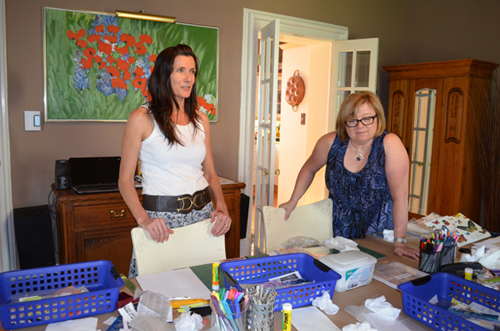 Students, Brenda and Charlotte, sharing their journal pages, May 2012. Having students share their reflections about the process and discoveries they’ve made during collage journaling is a vital element of the workshop. On a gorgeous afternoon last Saturday I held a collage journaling workshop in Carleton Place, Ontario. Charlotte, a former student, loaned me her beautiful home and recruited students for the class. Here are some photos and thoughts…
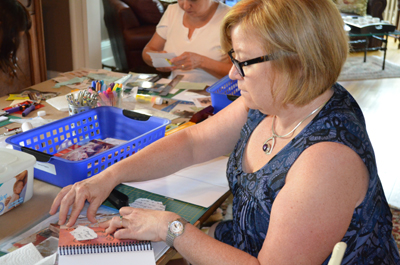 Charlotte creating a page, May 2012 Used to working in large format, Charlotte wasn’t sure if she could work within the confines of a 5 x 7 inch journal. Rising to the challenges it presented, she discovered she was indeed able to vary the size of her collage creations!… I love it when students expand their limits.
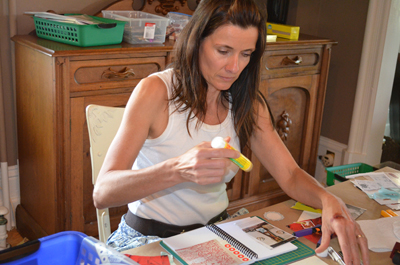 Brenda preparing her page, May 2012 Business professional Brenda had kept a written journal before and was intrigued by the possibilities of collage journaling. Especially because she and Charlotte had tons of fragments they’d collected while on a trip to Mysore, India. I suggested that this Indian adventure would be the perfect theme for a daily ephemera journal. To my delight Brenda already had a beautiful title for it: “India: Land of Contrast”.
 Mary tackling a two-page spread, May 2012 Mary, a high school teacher, was bitten by the visual journaling bug some months ago. Eager to improve her visual journaling skills, she came to class with an open mind and enthusiastic attitude – it’s wonderful to see students who embrace journaling this way!
For each workshop I have a special playlist I’ve created of my favourite music; it’s an eclectic mix of songs from the 1930’s to present; I always invite students to add a few of their tunes to it. When I discovered Mary didn’t really make it a point to listen to music while she journaled, I thought – oh, oh! In keeping with the spirit of the class, however, she offered to give it a try as well as contributing a Gordon Lightfoot song: “The Canadian Railroad Trilogy”: a fine folksy guitar rendition of early Canadian history.
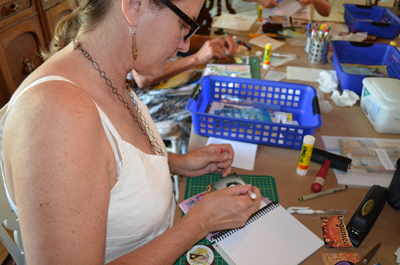 Maggie devising a page about a romantic adventure, May 2012 It was Maggie “Free Spirit” Jordan’s third class with me. I love having her because her enthusiasm is so infectious. A former graphic designer, she’s currently the owner of a new landscaping business. I draw much inspiration from her free-wheeling, intuitive approach to collaging. I didn’t know what she was doing at this point but I loved the way it was coming together!
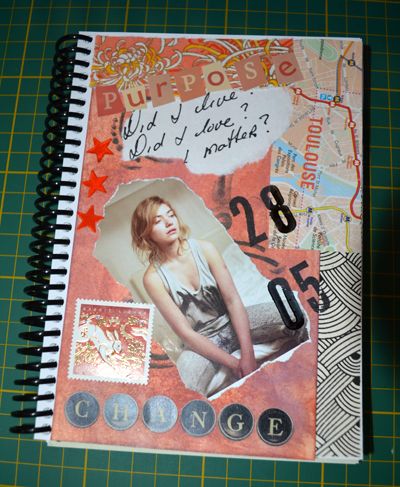 Charlotte's finished journal page; text: “Did I live? Did I love? Did I matter?” The date signifies the start date of her new job Charlotte’s finished journal page was about change and transformation. In the space of a few weeks, she’ll be starting a new job, selling her current home and purchasing a new one. The beautiful peachy tones of her page were inspired by a fragment of a handmade card she’d received from a friend. Instead of tucking this personal note into a drawer and perhaps never seeing it again and the wisdom it had to offer, I loved that she decided to memorialize it in her journal.
 Mary spontaneously added the text: “What’s on the end of her leash?” to her left page. One could read much into how that text works with the imagery on both pages! Viewing Mary’s pages in progress, I couldn’t help but wonder if Gordon Lightfoot’s music had influenced her choice of fragments: a European gone “native”, an explorer ship, map piece, native guide and an entomological drawing (insect). I was entranced by the endless horizon with bright clouds on her right page. By the end of the class she added a tiny found feather and placed it between the map and clouds – a magical gesture which lifted the page to a poetic level along with the gold speckled tissue her ship sails on… giving this history lesson/Robinson Crusoe adventure scene a touch of whimsy. I love that floating teapot on the left page as well – so surreal!
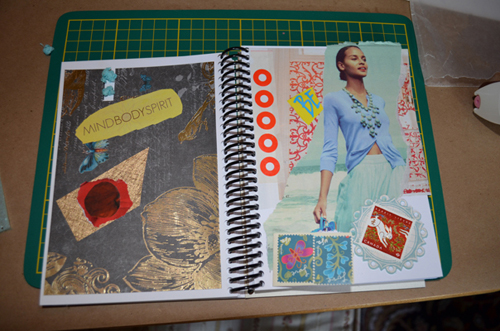 Brenda's finished journal pages. Adjusting to personal changes in her life, Brenda created a page that would help her to visualize these transitions in a positive light. I love the calming, happy, cool breezy feel of her right page; the play of pastel colours with the red and blue tones. I was blown away by the left side of the page with its minimalist compositional feel whose words invoked a oneness of being. The way the angular block-shaped gold piece echoes and contrasts with the detailed gold rose drawing beside it is breath-taking! Brenda informed us that the red and gold tones of this page are derived from Feng Shui in which these colours symbolize vitality and wealth, respectively. It’s so cool to incorporate meaningful colours into your pages; they can become part of your personal visual vocabulary.
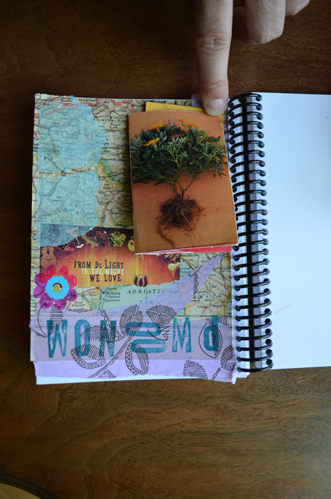 Maggie's mysterious finished journal page with card closed... text below card: “From de-light to the night we love”. 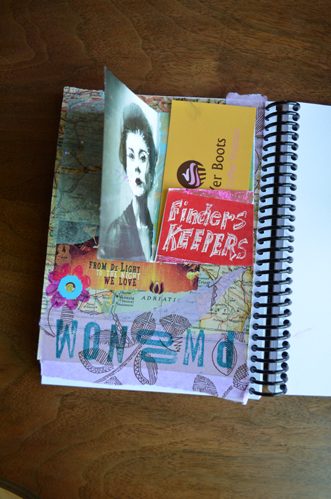 Maggie's finished page with card open... 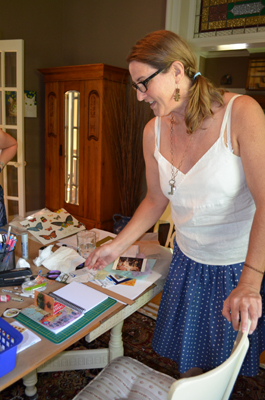 Maggie Jordan sharing her journal page... As Maggie described her journal page about a romantic vacation, she was naturally coy and sketchy about it; never giving away the more cryptic elements of her page! I love her layers upon layers: skin-like tissue paper over map pieces soften their mathematical/scientific surfaces; a card with golden uprooted marigold floats over the cartography of Europe, while inside the card, an enigmatic woman’s face which Maggie coloured (scribbled almost) over in pens adds mystery. A pocket inside the card held tags whose meaning only she could decode. Notice the beautiful randomness of the alphabet stampings on the bottom of the page… that’s Maggie playing with materials and tools allowing her wacky personality, fabulous sense of humour and brilliant graphic design sense to shine through!
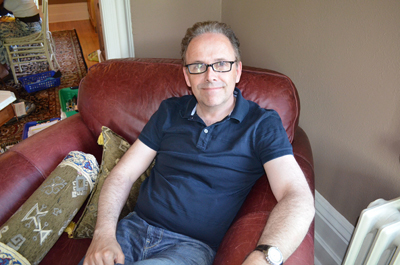 Kevin taking a break ... Kevin, my loyal assistant/hubby, helped out with my PowerPoint presentations. It’s so nice to add these professional touches to my workshops. Charlotte even had a big screen TV for us to watch them on – I was so spoiled! Kevin really enjoyed the afternoon as well.
Thanks to all the attendees: each of your pages is so inspiring! I learned much from your reflections. Thanks to Charlotte for opening up her beautiful country home to us as well as providing us with delectable goodies from the local farmers market and warm ginger lemon tea to soothe our creative souls. It was a truly memorable day!
Other Related Links:
Connie’s Journey: From Quilter to Collagist!
A Snapshot of Your Life Workshop
Creating Collage Using Daily Ephemera
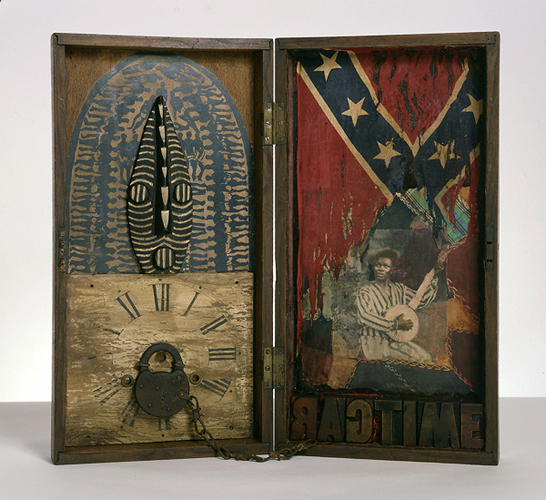 In Catherine's class we discussed Betye Saar's assemblage "Ragtime" (2005, 19" x 20" x 2") which references slavery, African-American music and the American Civil War. Since April, I’ve been volunteering at an elementary school. It’s one of my business goals to research working with children because I’d like to offer workshops for them at schools or through my studio. This year, an acquaintance/teacher friend, Christine, a great collage enthusiast, guided me through the appropriate administrative channels to be able to volunteer at her school. Angel that she is, she put in a great recommendation for me to the principal who sanctioned my presence there. Considerably under-funded in the area of fine arts, Christine assured me that my expertise would be valued by staff members there who were excited to involve artists in their school activities. Another reason I was compelled to volunteer at the school was that I learned that a number of students there came from subsidized housing communities. As a teen I lived in one close to the school for a number of years, I felt this heaven-sent opportunity was a chance to give back a little to my old neighborhood. I hoped the knowledge I passed on through art would one day become useful tools for survival and personal growth for the students. I’ve only spent a handful of days there so far and it’s been a rewarding experience.
Recently, I gave my first artist talk at the school to teacher Catherine’s grade six class. It was a dream come full circle for me. It doesn’t seem so long ago that I sat mesmerized by the words of a visiting artist at my school. Ever since then, I’ve dreamed of becoming one. Well, here I was finally (!), scared out of my wits about the prospect of giving a talk to a group of 11-year olds – worrying that I might not be cool enough to hold their attention. I worked for a number of days preparing a talk that would be fun, informative as well as interactive. I could have just showed slides on the computer screen to make things easier, but I opted to do a mix; including as many samples (and tools) of collage I could squeeze into the talk. As the students would soon be making their own collages based on their class’s theme of social justice, they were also seriously interested in learning strategies they could use to make their own collages. Their project is an exciting one; they’ll be creating pieces about the kind of “footprint” (legacy) they’d like to leave in the world. Open-minded Catherine sought me out because she felt that collaging was another valuable way of communicating thoughts and knowledge about these issues through images. The students carefully listened and actively participated in my discussion about collage which included a visual analysis of the work “Ragtime”, a collage/ assemblage by African-American artist Betye Saar, as well as a few pieces of my own. I never knew the history of slavery in grade six so I was pleased and astounded by the fact that Catherine’s students had already learned about slavery and the American Civil War. As a result, they were able to help me unlock several key elements of Saar’s art work. One young man even knew that ragtime was a genre of music! In discussing my work, “A Memory of a Photo of My Parents” one young lady beautifully summed up the story of my parents falling out of love – it was so touching. They were impressed by my Lady Gaga textures collage as well as my Michael Jackson one. When I mentioned I had recently done a piece about Marilyn Monroe, my namesake, a little girl in the front row whispered that she liked her too. Their admiration of my work made me feel like a kid again instead of a middle-aged woman! To my absolute delight, they asked dozens of questions. It was so exciting to give this talk. It easily surpassed the one I gave at an academic conference years earlier! Nothing compares to the energy and enthusiasm of kids who are really keen about learning something cool like collage!
I’ll leave you with some interesting questions they raised; they’re so telling of young minds. This ethically diverse group of 24 students was composed of half boys and half girls…
1 ) How long does it take to make a collage?
2 ) How do you make a smooth Modge Podge surface with your paint brush?
3 ) What order do you glue down collage pieces in?
4 ) Have you ever collaged on glass?
5 ) How much did your Michael Jackson collage sell for?
6 ) Was it sad to part with your favourite collages?
7 ) Do you ever make happy collages?
8 ) Do you ever make collages you hate?
9 ) Are your collages actually true stories about your life?
It was a day to remember. As I reflected upon their feedback: I imagined them as future thinkers, innovators, musicians, marketing specialists, critics and perhaps, even a fine artist or two! Thanks to the kids, Catherine and Christine for giving me the opportunity to grow as an artist. Thanks to my husband Kevin who assisted me and listened to hundreds of versions of my talk before class! Lastly thanks, to Elaine Coombs, my favourite tree painter from San Francisco, who came to my rescue with tips on giving artist talks.
Other Related Links:
New York Times article about Betye Saar
Betye Saar Red Time Gallery Tour
As a collage artist who draws on very personal issues in her work, I’m always excited to see other artists doing the same. Seeing the work of other artists is also vital to keeping my creative capacities sharp and inspired. One of my favourite art coaches Alyson Stanfield (Art Biz Blog) recently noted how important it is to keep the work of artists alive in the public’s imagination as well, so here’s a recollection of an amazing show I visited this spring…
It’s a sunny April day and I’m on my way to the Ottawa City Hall Art Gallery to see photographer Jonathan Hobin’s Show “Little Lady/Little Man”. Sitting on the bus, I spy a woman and her baby and a song springs into my head … I hear my mother’s voice… she’s singing a song with nonsense words she used to sing to my younger siblings. The sound of this happy, silly tune always made them smile, feel safe and loved. Its funny how, decades later, I can still hear it so clearly. It’s amazing how a simple tune sung to you at a most vulnerable age can have such powerful long-lasting effects on your being…
A Journey through Time…
Before I know it, I’ve walked into Hobin’s exhibition. The gallery’s a little darker than usual, I wonder if I’ve missed the show until I’m greeted by three gleaming, haunting life size photographs of an old man hanging before me. Relieved I haven’t missed the show, I walk along the left wall of the gallery where I sense the story begins. Here I’m greeted by a series of vintage photo portraits of Hobin’s grandmother that transport through time to various stages of her life: as a young girl; with her sister; as a bride and as a mother with a small child. I think how quickly life goes by…
Beneath a Glass Case…
From there, I reach the far wall of the gallery. In front of me, beneath a coffin-like glass case, is a life-size portrait of Hobin’s dying grandmother lying in a fetal position in bed. The photograph, as with all the photographs in the show (excluding the first series I mentioned), is printed on aluminum so her image shimmers under the spotlights above it. Under glass, she is transformed into an aging fairy tale princess or the ancient remains of a far-off ancestor frozen in time. Her image is troubling, beautiful and poignant. Hobin’s monochromatic image takes me back to the time when Victorians had photographic portraits taken of their dead loved ones as keepsakes. For the average person then this was not a morbid image but cherished photo; also perhaps the only record of a loved one they owned: a precious memento mori. As I dwell on this, I become aware of the sound of heavy breathing. It’s not my imagination. It’s a recording Hobin has made of the last dying breaths of his grandmother. Solemnly, I proceed to the next space…
A Sacred Chamber…
This area is enclosed by two walls on either side. In this darkened tomb-like, womb-like room hangs a large portrait of Hobin’s grandmother’s face; she appears to be sleeping or perhaps near death. For me this sacred blackened chamber is like a nether world; a place where life ends and death begins. My mind flashes back to my late father dying of cancer and I feel as though I’m at Hobin’s grandmother’s bedside hearing her take her last breaths. It’s hard for me to tear myself away from this space because I know I’ve been here before; sitting beside a loved one’s bed; agonizing for minutes, hours, days, months and years. Wondering which will be the moment they draw their last breath. It’s difficult to leave, but somehow I manage to tear myself away…
One Last Goodbye…
I walk around the wall and encounter the three hanging life-size portraits I saw upon entering the gallery. The first is of Hobin’s elderly grandfather in pants naked from the waist up; his pacemaker protruding from his chest. The next is an image of him in full suit. The last, he’s in formal attire with Hobin’s grandmother who’s sporting a beautiful fur coat. They’re posing in the same style my parents and grandparents did in their old photos: heads up, a bit stout, standing proud… like they’re saying one final grand goodbye to life. These aluminum prints sparkle in the spotlights making his grandparents seem like angels, even sentinels. They make me think of the reredos (altarpieces) in Catholic churches that reveal the mysteries of heavenly deities. In the form of a triptych, as a fallen Catholic, I see these images as sacred, as spiritual. I love the way this series commands power and reverence and gives a great dignity to the couple.
Like a Gilded Statue of a Saint…
Alongside the left wall, the exhibit is completed by another series of three close-up life-size portraits of Hobin’s grandfather focusing on his heart, legs and head. They’re based on a phrase Hobin’s grandfather told him as a child. I don’t have to scrutinize these images too much to see the wear and tear on the elderly man’s body. On aluminum his skin takes on the immortal patina of the gilded statues of saints I’ve seen in churches. As I contemplate these pieces, Hobin’s grandfather’s voice beckons me and compels me to take a seat in the gallery and listen to what he has to say… expanding the scope of my reverie… perhaps too, unraveling the mystery of his life…
A Gift of Song…
I’m all ears as Hobin’s grandfather sings songs to his daughters and granddaughters; to his sons and grandsons. Their titles* beginning with the name of the exhibition: “Little Lady/Little Man”. I discover that these are the songs he grew up with and are the legacy he wants to leave to future generations of his family. Hobin found secret recordings of them left by his grandfather and decided to use them in his show. For me they are the glue that binds the whole show together along with its beautiful intimate lighting effects. As I listen to the old man singing, I feel I have to leave before I completely break down. I’m also hearing my father’s own melodic voice singing songs to me as a child. I’m a sensitive soul and Hobin’s thoughtfully laid out installation has worked its magic on me. To me this is art at its best: when you’re left with not only the images the artist has conjured up, but also the ghosts of your own life.
Exploitation or Loving Memorial?
Hobin has been criticized for exploiting his grandparents in this installation; for photographing his grandmother in a most vulnerable state, but in fairness it’s important to note that the couple whole-heartedly supported his photographic career during life and his grandfather sanctioned the use of some of the photos in the show. For me, Hobin’s installation therefore becomes a touching private/public memorial to them… reminding viewers of the nearness of our own death and of those we love as well as the importance of legacy. Hobin’s grandfather has left him a song. As I leave, I can’t but help recall a song my grandmother Sophie sang to me before she died: “Life is Just a Bowl of Cherries”. I can still hear her singing its final lyrics: “But you can’t take your dough, when you go, go, go!” When she died she left me two miniature books of quotations of great philosophers and saints and a box of old buttons. Long ago I decided my legacy would be my art. And you my dear readers, what will you leave behind?
To see some of the images and learn more about Jonathan Hobin’s exhibition see the Ottawa Citizen’s Blog as well as Hobin’s website.
*Note: The song titles are: “Little Lady Make Believe” and “Little Man You’ve Had a Busy Day”.
|
|










































